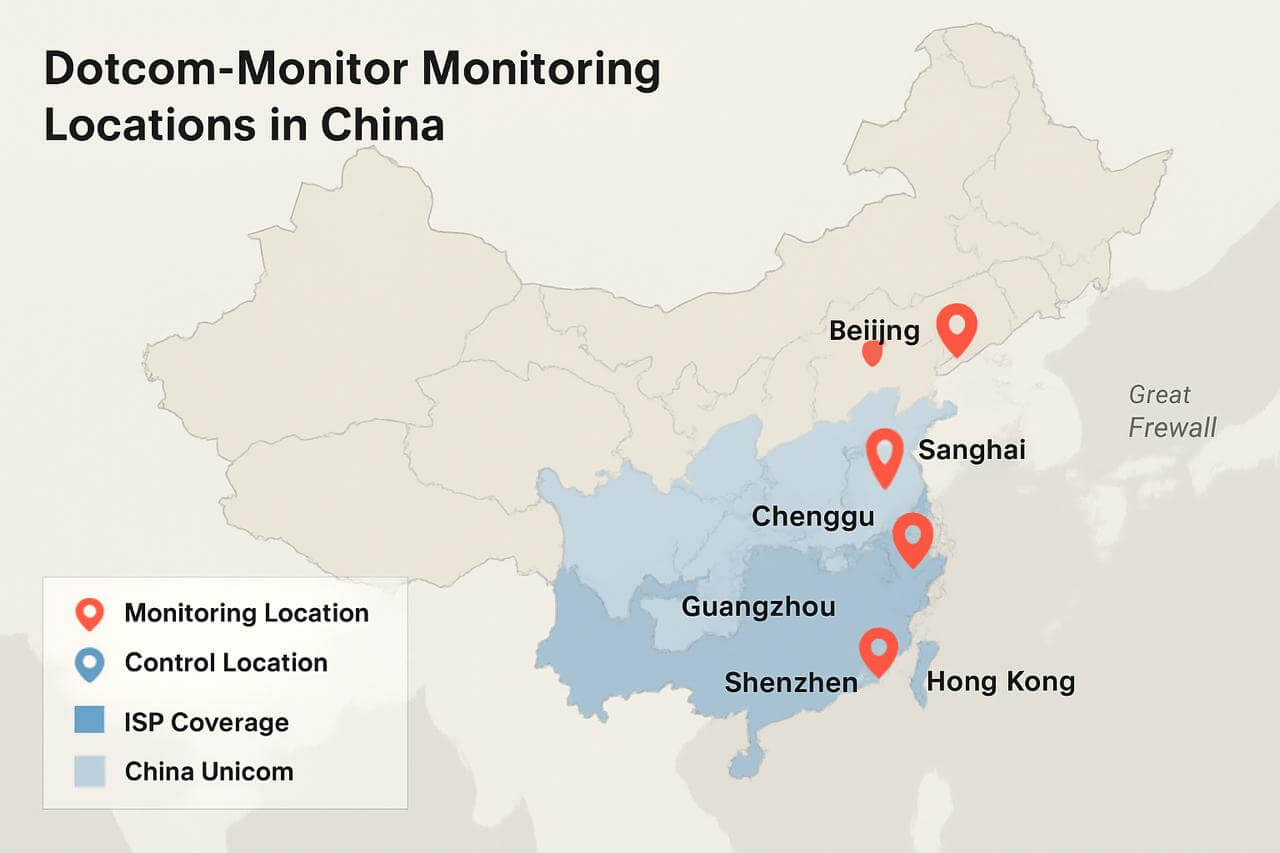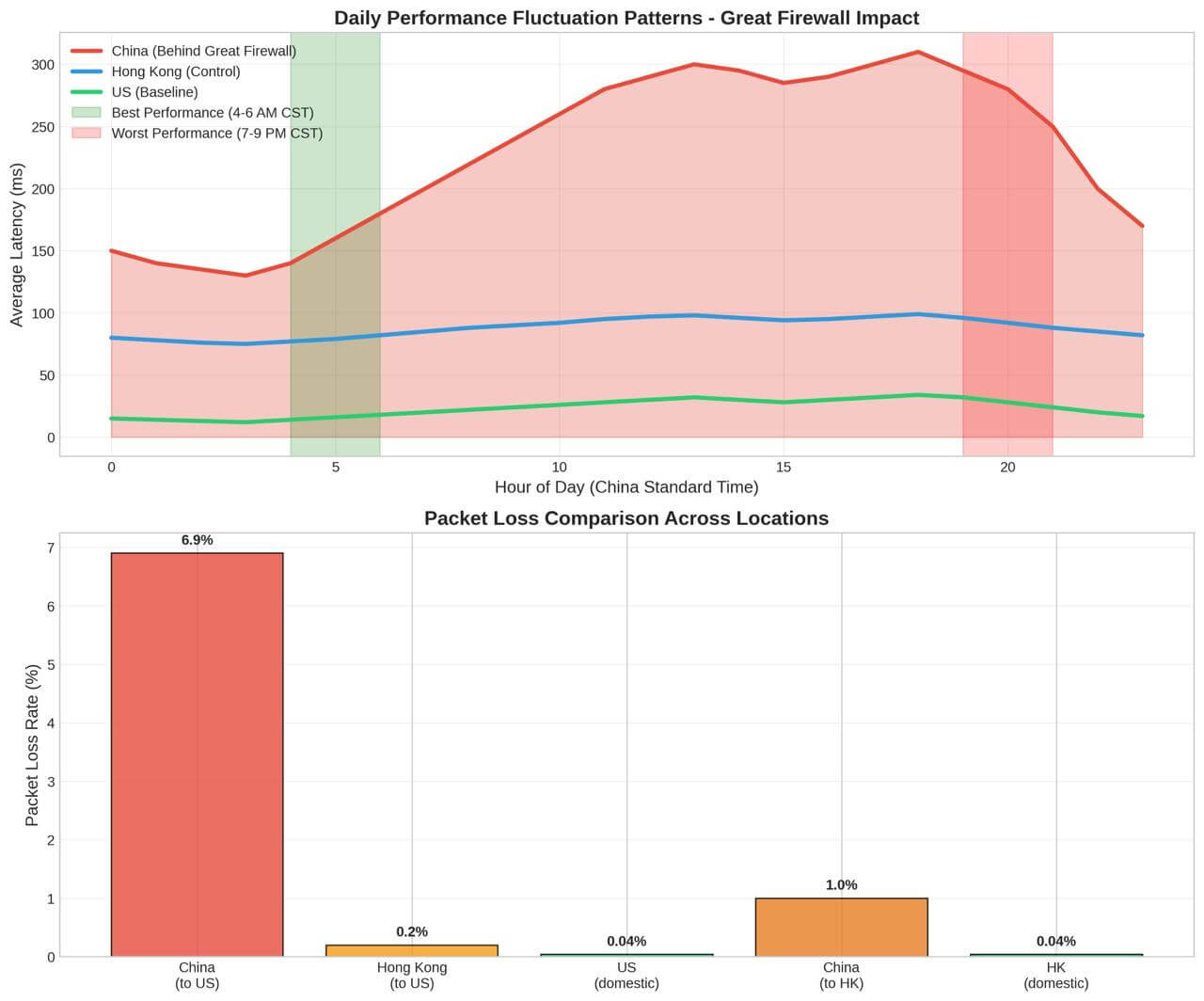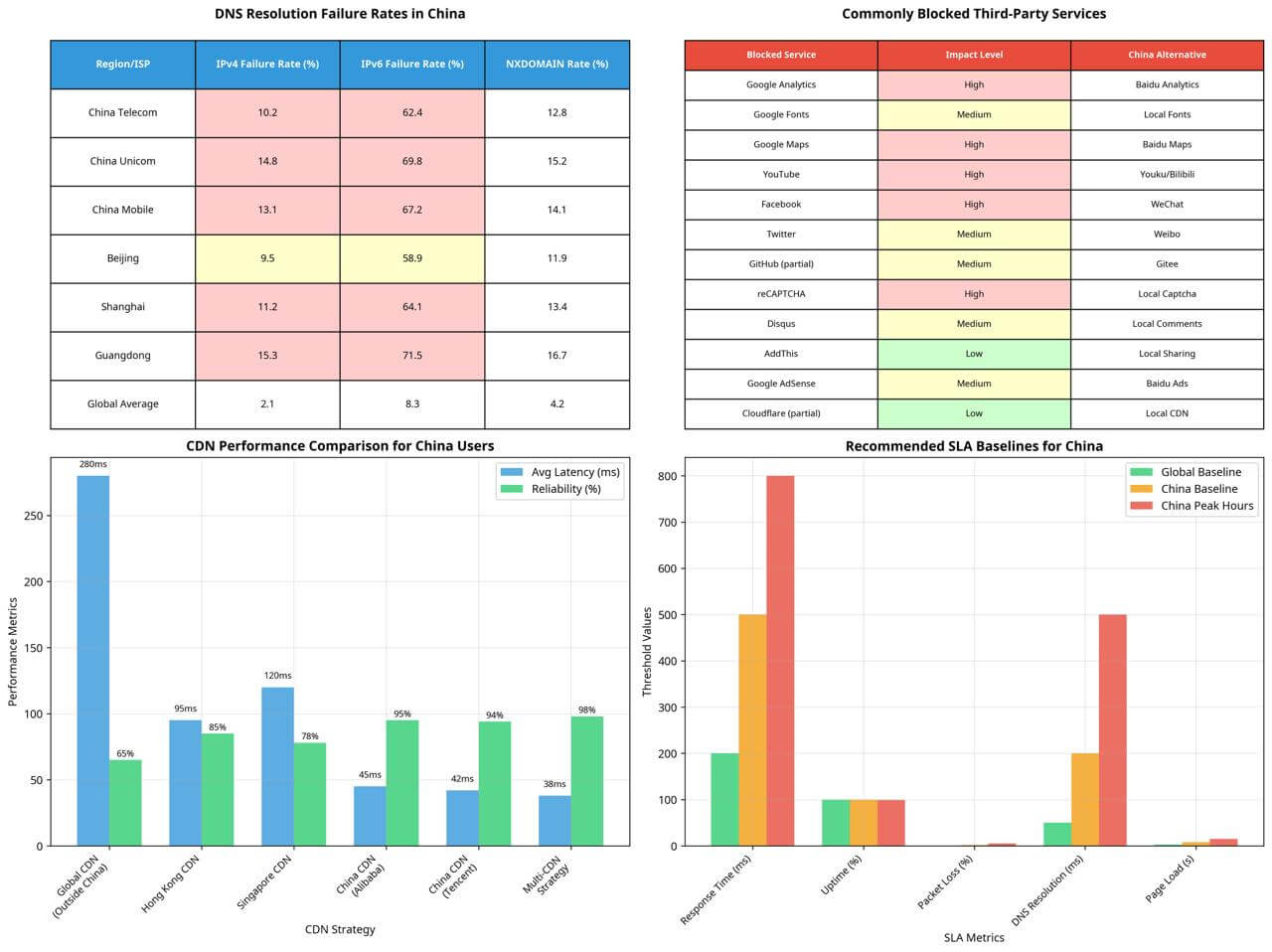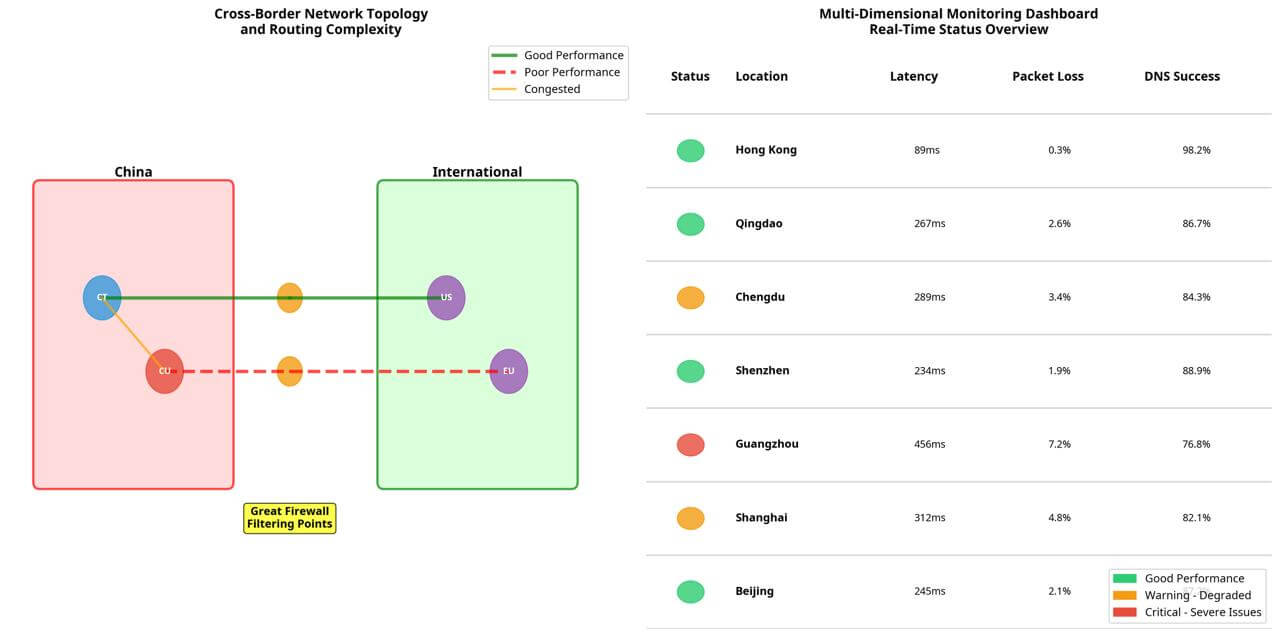Executive Summary
As Site Reliability Engineers (SREs) managing global infrastructure, we face unique challenges when serving users in mainland China. The Great Firewall of China creates a complex web of technical obstacles that can render even the most robust international websites slow, unreliable, or completely inaccessible to Chinese users. This comprehensive analysis examines Dotcom-Monitor’s monitoring capabilities within China, providing technical insights into the performance patterns, infrastructure challenges, and monitoring strategies essential for maintaining service reliability behind the Great Firewall.
Through detailed analysis of Dotcom-Monitor’s six monitoring locations within mainland China (Beijing, Chengdu, Guangzhou, Qingdao, Shanghai, and Shenzhen), we explore how the Great Firewall’s sophisticated filtering mechanisms create daily performance fluctuations, DNS resolution issues, and content delivery challenges that require specialized monitoring approaches. This technical deep-dive addresses ten critical questions that every SRE must consider when monitoring websites hosted outside China but serving Chinese users.
Introduction: The Technical Reality of China’s Internet Infrastructure
China’s internet infrastructure operates as a fundamentally different ecosystem from the global internet, creating unique challenges for SREs responsible for international service delivery. The Great Firewall of China, officially known as the Golden Shield Project, represents the world’s most sophisticated internet censorship and traffic management system, employing multiple layers of filtering, inspection, and routing control that directly impact website performance and reliability.
From a technical perspective, the Great Firewall operates through a complex architecture that includes DNS manipulation, deep packet inspection (DPI), IP address blocking, URL filtering, connection reset mechanisms, and VPN detection systems. These systems are not merely binary allow/deny filters but sophisticated traffic management tools that introduce variable latency, packet loss, and connection instability that fluctuates throughout the day based on traffic patterns, content sensitivity, and government policy enforcement.
For SREs, this creates a monitoring challenge unlike any other global region. Traditional monitoring approaches that work effectively in North America, Europe, or other Asian markets fail to capture the nuanced performance degradation and intermittent failures that characterize cross-border internet traffic in China. Dotcom-Monitor’s presence within mainland China provides critical visibility into these performance patterns, offering SREs the data necessary to understand, predict, and mitigate the impact of the Great Firewall on their services.
Understanding Dotcom-Monitor’s China Infrastructure

Dotcom-Monitor operates monitoring agents in six strategic locations within mainland China, each positioned behind the Great Firewall and subject to the same filtering and routing constraints that affect real Chinese users. These locations include Beijing (the political and technological center), Shanghai (the financial hub), Guangzhou (the manufacturing and trade center), Shenzhen (the technology innovation center), Chengdu (the western regional hub), and Qingdao (the eastern coastal industrial center).
The strategic distribution of these monitoring points provides comprehensive coverage across China’s diverse network infrastructure, which is dominated by two major ISPs: China Telecom and China Unicom. These ISPs operate under government oversight and implement routing policies that can vary significantly between regions, creating performance disparities that require multi-location monitoring to fully understand.
Importantly, Dotcom-Monitor also maintains a monitoring agent in Hong Kong, which operates outside the Great Firewall’s jurisdiction. This provides a crucial control point for SREs to isolate the performance impact of the Great Firewall from other factors such as geographic distance or general network congestion. The Hong Kong agent serves as a baseline for understanding what performance would look like without firewall interference, enabling more accurate root cause analysis when performance issues arise.
The technical architecture of Dotcom-Monitor’s China monitoring agents is designed to simulate real user behavior from within the constrained environment of China’s internet infrastructure. These agents are subject to the same DNS resolution issues, content blocking, and traffic shaping that affect actual Chinese users, providing authentic performance data that reflects the real user experience rather than idealized network conditions.
1. Great Firewall Filtering: Technical Architecture and Performance Impact

The Great Firewall’s filtering mechanisms represent one of the most sophisticated traffic management systems ever deployed at national scale. From an SRE perspective, understanding these mechanisms is crucial for predicting and diagnosing performance issues that affect Chinese users.
Multi-Layer Filtering Architecture
The Great Firewall employs a multi-layered approach to traffic filtering that operates at different levels of the network stack. At the DNS level, the system implements widespread DNS poisoning and spoofing, manipulating DNS caches to contain incorrect IP addresses for blocked domains. This creates a fundamental challenge for SREs, as DNS resolution failures can appear as network connectivity issues rather than deliberate blocking.
The system also implements comprehensive IP address blocking, preventing access to specific IP ranges regardless of the domain name used to access them. This technique has become increasingly sophisticated since 2022, with the firewall now capable of blocking direct IP access even when DNS resolution is bypassed. For SREs managing CDN configurations, this means that failover strategies relying on IP-based access may not work reliably in China.
At the application layer, the Great Firewall performs deep packet inspection (DPI) on unencrypted traffic, scanning for sensitive keywords, prohibited content, and specific protocol patterns. This inspection process introduces variable latency that depends on traffic volume, content sensitivity, and the computational overhead of the inspection algorithms. During peak hours, when inspection systems are under heavy load, this can add hundreds of milliseconds to response times.
Performance Impact Quantification

Dotcom-Monitor’s data provides concrete evidence of the Great Firewall’s performance impact. In comparative testing of Amazon.com, monitoring agents in Guangzhou recorded average response times of 30.4 seconds, compared to 4.42 seconds from New York and 2.76 seconds from Hong Kong. This dramatic difference demonstrates that geographic distance alone cannot account for the performance degradation experienced by Chinese users.
The performance impact varies significantly based on content type and destination. Static assets hosted on CDNs may experience different filtering overhead than dynamic API calls, and certain domains or IP ranges may be subject to more aggressive inspection than others. SREs must account for this variability when setting performance baselines and alerting thresholds for Chinese traffic.
2. DNS Resolution Issues: ISP Behavior and Systematic Failures
DNS resolution in China presents unique challenges that go far beyond the typical DNS issues encountered in other regions. Chinese ISPs exhibit systematic behaviors that can cause resolution failures, inconsistent responses, and performance degradation that directly impacts user experience.

ISP-Specific DNS Behavior Patterns
Research from major Chinese DNS infrastructure providers reveals significant disparities in DNS resolution success rates across different ISPs and regions. Chinese DNS resolvers demonstrate a 66% failure rate for IPv6 queries and a 12.5% failure rate for IPv4 queries, substantially higher than global averages. These failures are not random but follow predictable patterns based on ISP infrastructure, regional routing policies, and government filtering requirements.
China Telecom and China Unicom, the two dominant ISPs, implement different DNS resolution strategies that can lead to inconsistent behavior for the same domain queries. This inconsistency is particularly problematic for SREs managing global load balancing or geographic routing, as DNS-based traffic distribution may not work reliably across different Chinese ISPs.
DNS Cache Poisoning and Manipulation
The Great Firewall implements systematic DNS cache poisoning as a primary censorship mechanism, manipulating DNS responses to redirect traffic away from blocked domains. This poisoning affects not only obviously blocked domains but can also impact legitimate domains that share infrastructure or IP ranges with blocked services.
For SREs, this creates a particularly insidious problem: DNS resolution may appear to work correctly from external monitoring points while failing or returning incorrect results for users within China. Dotcom-Monitor’s China-based agents provide visibility into these DNS manipulation events, allowing SREs to detect when their domains are affected by collateral DNS poisoning.
3. CDN and Asset Delivery Challenges: The Complexity of Content Distribution
Content Delivery Networks (CDNs) face unique challenges when serving users in China, with traditional global CDN strategies often proving inadequate or counterproductive behind the Great Firewall. Understanding these challenges is essential for SREs designing content delivery strategies for Chinese users.
Global CDN Limitations in China
Global CDNs without mainland China presence face fundamental limitations that cannot be overcome through traditional optimization techniques. Even when CDN edge nodes are located in geographically proximate locations such as Hong Kong or Singapore, traffic must still traverse the Great Firewall to reach Chinese users, subjecting it to the same filtering, inspection, and throttling mechanisms that affect direct origin server connections.
The performance impact of this limitation is substantial. Research demonstrates that CDN edge nodes outside mainland China provide minimal performance benefit for Chinese users, with response times often remaining in the hundreds of milliseconds despite geographic proximity. This occurs because the Great Firewall’s inspection and filtering processes introduce latency that overwhelms the benefits of reduced geographic distance.
Blocked Third-Party Dependencies
One of the most significant challenges for SREs is the widespread blocking of third-party services and dependencies that are commonly used in modern web applications. Google services, including Google Analytics, Google Fonts, Google Maps APIs, and reCAPTCHA, are systematically blocked or severely throttled in China. Social media widgets from Facebook, Twitter, and YouTube are similarly inaccessible, as are many development and analytics tools that websites rely on for functionality and monitoring.
This blocking creates a cascading failure scenario where websites may appear to load but lack critical functionality due to failed third-party resource loading. From a monitoring perspective, this means that traditional uptime checks may report success while users experience broken or severely degraded functionality. Dotcom-Monitor’s real browser testing capabilities within China can detect these partial failures that simple HTTP checks would miss.
4. Accurate Performance Metrics: Understanding Real User Experience
Obtaining accurate performance metrics for Chinese users requires a fundamentally different approach than monitoring in other global regions. The unique characteristics of China’s internet infrastructure mean that external monitoring points cannot provide reliable indicators of actual user experience within China.
Latency Patterns and Baseline Establishment
Network latency from China to international destinations follows predictable but complex patterns that vary based on time of day, traffic volume, and Great Firewall processing overhead. Research from ThousandEyes demonstrates that latency from Chinese monitoring points to US websites ranges from approximately 150ms during low-traffic periods (4-6 AM China Standard Time) to over 300ms during peak hours (7-9 PM China Standard Time).
These diurnal patterns are not simply due to network congestion but reflect the increased processing overhead of the Great Firewall’s inspection systems during high-traffic periods. The filtering infrastructure requires more time to process and inspect traffic when volumes are high, creating predictable performance degradation that SREs must account for in their monitoring and alerting strategies.
Packet Loss and Connection Reliability
Packet loss rates from China to international destinations are significantly higher than typical internet standards, with rates of 6.9% being common for traffic to US websites compared to 0.04% for domestic US traffic. This high packet loss rate is not indicative of network infrastructure problems but rather reflects the normal operation of the Great Firewall’s filtering and inspection systems.
5. Content Blocking and Inaccessibility: Detection and Mitigation Strategies
Content blocking in China operates through sophisticated mechanisms that can cause complete inaccessibility, partial functionality loss, or intermittent failures that are difficult to detect and diagnose. SREs must implement comprehensive monitoring strategies to identify these issues before they impact user experience.
Silent Blocking Mechanisms
The Great Firewall’s blocking mechanisms are designed to be opaque, providing no clear indication to users or monitoring systems that content has been deliberately blocked. Instead of displaying explicit block pages or error messages, the system typically manifests blocking through connection timeouts, DNS resolution failures, or infinite loading states that can be mistaken for network connectivity issues.
This stealth approach to blocking creates significant challenges for SREs, as traditional monitoring alerts may not trigger when content is blocked. A website may appear to be experiencing network issues or server problems when the actual cause is content filtering. Dotcom-Monitor’s China-based monitoring agents can detect these blocking events by comparing performance and accessibility across different locations and identifying patterns consistent with deliberate filtering.
6. Regulatory and Compliance Monitoring: Navigating Policy Enforcement
Chinese internet regulations create a complex compliance landscape that directly impacts website accessibility and performance. SREs must understand these regulatory requirements and implement monitoring strategies that can detect compliance-related disruptions.
ICP Licensing and Domain Registration Requirements
The Internet Content Provider (ICP) licensing system requires websites serving Chinese users to obtain government approval and register their domains with Chinese authorities. Websites without proper ICP licensing may experience blocking, throttling, or other performance degradation as enforcement mechanisms are applied.
Monitoring for compliance-related issues requires understanding the relationship between licensing status and performance patterns. Websites with proper ICP licensing may experience different performance characteristics than those operating without compliance, and changes in licensing status can trigger sudden accessibility changes that appear as technical failures.
7. Local ISP Routing Variability: Understanding Network Diversity

China’s internet infrastructure exhibits significant routing variability across different ISPs and regions, creating performance disparities that require comprehensive monitoring to understand and optimize.
ISP Infrastructure Differences
China’s internet landscape is dominated by China Telecom and China Unicom, but these ISPs implement different routing policies, infrastructure investments, and performance characteristics that can significantly impact user experience. The technical differences between these ISPs extend beyond simple capacity differences to include routing preferences, international connectivity strategies, and traffic management policies.
China Telecom generally provides better international connectivity and lower latency to overseas destinations, while China Unicom may offer superior domestic performance but higher international latency. These differences mean that the same website may perform dramatically differently for users on different ISPs, requiring monitoring strategies that account for ISP-specific performance patterns.
BGP and Routing Control Limitations
Unlike most international markets where ISPs have significant control over BGP routing decisions, Chinese ISPs operate under government oversight that can limit their routing optimization options. Dotcom-Monitor’s documentation specifically notes that they “do not have control of BGP (routing) in our data centers in China” because “BGP is controlled by a government entity”.
This government control over routing decisions means that network performance issues may not be resolvable through traditional technical optimization approaches. SREs must understand these limitations and implement monitoring strategies that can detect routing-related performance issues while recognizing that resolution may require policy-level changes rather than technical interventions.
8. Improved User Support and SLA Accuracy: Data-Driven Service Management
Accurate monitoring from within China is essential for providing effective user support and maintaining realistic Service Level Agreements (SLAs) for Chinese users. The unique performance characteristics of China’s internet environment require specialized approaches to service management and customer support.
SLA Definition and Baseline Establishment
Traditional SLA metrics developed for global audiences are often inappropriate for Chinese users due to the fundamental differences in network performance characteristics behind the Great Firewall. Response time targets that are easily achievable in North America or Europe may be impossible to meet consistently in China due to the inherent latency and packet loss introduced by filtering and inspection systems.
SREs must establish China-specific SLA baselines that account for the normal operation of the Great Firewall while still providing meaningful performance targets. This requires extensive historical data collection from China-based monitoring points to understand typical performance ranges and establish realistic expectations for different types of traffic and content.
9. Third-Party Service Failure Detection: Dependency Management
Modern web applications rely heavily on third-party services for functionality ranging from analytics and advertising to payment processing and user authentication. In China’s internet environment, these dependencies create significant reliability risks that require specialized monitoring approaches.
Comprehensive Dependency Mapping
Effective monitoring in China requires comprehensive mapping of all third-party dependencies and their accessibility status within China. Services that are reliable globally may be completely blocked or severely degraded in China, creating cascading failures that can render applications unusable even when core infrastructure remains functional.
This dependency mapping must be maintained continuously as blocking patterns evolve and new services are introduced. SREs must implement monitoring strategies that can detect when previously accessible third-party services become blocked or degraded, allowing for rapid implementation of alternative solutions.
10. Business Reputation Protection: Proactive Performance Management
Maintaining business reputation in China requires proactive performance management that prevents issues from impacting user experience and demonstrates commitment to serving Chinese customers effectively.
Performance Optimization Strategies
Effective performance optimization for Chinese users requires understanding the specific technical constraints and opportunities within China’s internet environment. Traditional optimization techniques may be ineffective or counterproductive when applied without consideration of the Great Firewall’s impact on traffic patterns and content delivery.
Optimization strategies must account for the unique characteristics of China’s internet infrastructure, including the importance of local hosting, the need for alternative third-party services, and the impact of content sensitivity on performance. SREs must implement comprehensive monitoring to measure the effectiveness of optimization efforts and ensure that changes actually improve user experience.
Dotcom-Monitor’s Technical Advantages for China Monitoring
Dotcom-Monitor’s approach to China monitoring provides several technical advantages that address the unique challenges of monitoring behind the Great Firewall. Understanding these advantages helps SREs make informed decisions about monitoring strategies and tool selection.
Authentic User Experience Simulation
Dotcom-Monitor’s monitoring agents within China are subject to the same filtering, routing, and performance constraints that affect real Chinese users. This authentic environment provides monitoring data that accurately reflects user experience rather than idealized network conditions that might be measured from external monitoring points.
The real browser testing capabilities provided by Dotcom-Monitor’s EveryStep scripting tool allow for comprehensive testing of user workflows and detection of issues that simple HTTP monitoring would miss. This includes testing of JavaScript execution, third-party resource loading, and complex user interactions that are critical for modern web applications.
Comprehensive Geographic Coverage
The six monitoring locations within mainland China provide comprehensive coverage of China’s diverse network infrastructure and regional performance variations. This distributed monitoring approach allows SREs to understand performance patterns across different ISPs, regions, and network conditions rather than relying on data from a single location that might not be representative of the broader Chinese user base.
Implementation Recommendations for SREs
Based on the technical analysis of China’s internet environment and Dotcom-Monitor’s capabilities, several key recommendations emerge for SREs implementing monitoring strategies for Chinese users.
Establish China-Specific Baselines
SREs must establish performance baselines that are specific to China’s internet environment rather than applying global standards that may be inappropriate for the Chinese context. These baselines should account for the normal operation of the Great Firewall, including diurnal performance patterns, typical packet loss rates, and expected latency ranges.
Implement Multi-Dimensional Monitoring
Effective monitoring in China requires a multi-dimensional approach that includes multiple geographic locations, different ISPs, various content types, and complete user workflows. Single-point monitoring is insufficient for understanding the complex performance patterns and failure modes characteristic of China’s internet environment.
Develop China-Specific Incident Response Procedures
Incident response procedures for Chinese users must account for the unique technical constraints and resolution options available in China’s internet environment. Issues that can be resolved quickly through traditional technical means in other regions may require different approaches or may not be resolvable at all due to policy or infrastructure constraints.
Conclusion: The Strategic Importance of China-Based Monitoring
Monitoring website performance from within China is not merely a technical nicety but a strategic necessity for any organization serving Chinese users. The unique characteristics of China’s internet environment create performance and reliability challenges that cannot be understood or addressed through external monitoring approaches.
Dotcom-Monitor’s comprehensive monitoring infrastructure within China provides SREs with the visibility necessary to understand, predict, and respond to the complex technical challenges of serving users behind the Great Firewall. From the sophisticated filtering mechanisms that create daily performance fluctuations to the DNS resolution issues that can cause intermittent failures, the technical challenges of China’s internet environment require specialized monitoring approaches that account for the unique constraints and opportunities of this market.
The ten critical areas examined in this analysis—from Great Firewall filtering and DNS resolution issues to CDN challenges and regulatory compliance—demonstrate the complexity of maintaining reliable service for Chinese users. Each area requires specific technical understanding and monitoring strategies that go beyond traditional global monitoring approaches.
For SREs responsible for global service delivery, implementing comprehensive China monitoring is essential for maintaining service reliability, providing effective user support, and protecting business reputation in one of the world’s largest and most important internet markets. The investment in China-specific monitoring capabilities pays dividends in improved user experience, reduced support costs, and enhanced competitive positioning in the Chinese market.
As China’s internet environment continues to evolve, with new regulations, infrastructure developments, and policy changes affecting service delivery, the importance of comprehensive monitoring will only increase. SREs who implement robust China monitoring strategies today will be better positioned to adapt to future changes and maintain service excellence for their Chinese users.
The technical challenges of monitoring behind the Great Firewall are significant, but they are not insurmountable. With the right tools, strategies, and understanding of the technical environment, SREs can successfully navigate these challenges and deliver reliable, high-performance services to users throughout China. Dotcom-Monitor’s China monitoring capabilities provide a solid foundation for this effort, offering the visibility and insights necessary to succeed in this complex but critically important market.
